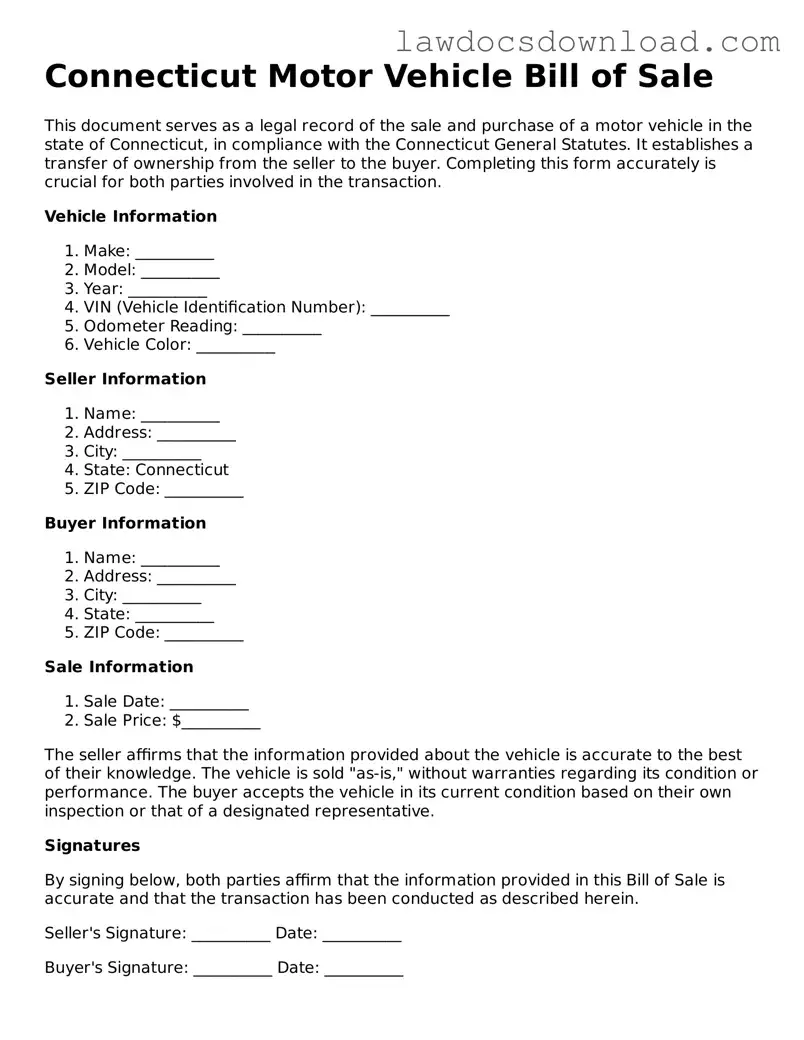The Connecticut Motor Vehicle Bill of Sale form shares similarities with the General Bill of Sale form. Both documents function as written evidence of the transfer of ownership between two parties. While the General Bill of Sale can be used for various types of personal property like electronics or furniture, the Motor Vehicle Bill of Sale is specifically tailored for transactions involving motor vehicles. Each form typically includes details about the seller, the buyer, the item sold, and the sale date, ensuring the transaction is properly documented and legally valid.
Another document resembling the Connecticut Motor Vehicle Bill of Sale is the Vessel Bill of Sale. This document is used in the sale and purchase of a boat or vessel. Like the Motor Vehicle Bill of Sale, it records the specifics of the transaction, including identifying information about the vessel, the sale price, and the parties involved. The primary difference lies in the subject of the sale, focusing on watercraft rather than motor vehicles, but both serve the purpose of demonstrating a change in ownership under the law.
The Aircraft Bill of Sale is also akin to the Connecticut Motor Vehicle Bill of Sale but is utilized in the buying and selling of airplanes. It includes critical details similar to those found in the motor vehicle version, such as the make and model of the aircraft, the names and addresses of both the buyer and seller, and the transaction particulars. This document is essential for recording ownership changes of aircraft and ensuring compliance with federal aviation regulations.
Comparable to the Motor Vehicle Bill of Sale is the Firearm Bill of Sale. This document is specifically designed for transactions involving guns and firearms. Although its focus is different, it operates under the same principle of documenting the transfer of ownership from one individual to another. It typically includes the make, model, and serial number of the firearm, alongside the personal details of the buyer and seller and the terms of the sale, providing a clear record of the transaction for legal and registration purposes.
The Pet Bill of Sale is another document related to the Connecticut Motor Vehicle Bill of Sale, tailored for transactions involving animals, particularly pets. While it records a change in ownership like the other bills of sale, this form pays special attention to the details relevant to animals, such as breed, date of birth, and health information. Both documents serve the essential function of establishing new ownership, although the Pet Bill of Sale also often includes terms regarding the welfare and future care of the animal.
Last but not least, the Business Bill of Sale stands similar to the Connecticut Motor Vehicle Bill of Sale, in that it is used to document the sale of assets or ownership interests in a business. This form captures intricate details about the business being sold, including assets, stock, and intellectual property, similar to how vehicle details are documented in the Motor Vehicle Bill of Sale. Both forms are crucial for the clear documentation of a legal transfer of ownership, ensuring that all parties have a record of the agreement and its terms.
